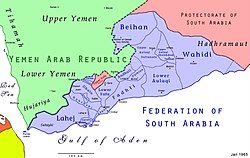Al-Busi
Bu`si Sheikdom مشيخة البعسي | |||||||
|---|---|---|---|---|---|---|---|
| c. 18th century–1967 | |||||||
 | |||||||
| Largest city | |||||||
| Common languages | Arabic | ||||||
| Religion | Islam | ||||||
| Government | Monarchy | ||||||
| Sheikh | |||||||
• 1903-1954 | 2 rulers, names unknown | ||||||
| History | |||||||
• Established | c. 18th century | ||||||
• British protectorate | 1954 | ||||||
• Disestablished | 1967 | ||||||
| Population | |||||||
• 1917[1] | 2000 | ||||||
| |||||||
| Today part of | Yemen | ||||||
Al-Bu`si, Busi, Bo'sī,[1] (Arabic: البعسي Bu`sī), or the Bu`si Sheikhdom (Arabic: مشيخة البعسي Mashyakhat al-Bu`sī), was a small state in the British Aden Protectorate. It was one of the states of Upper Yafa.[1]
History[]
Busi was established around the 18th century.[citation needed]
Protectorate treaties were signed with the other states of Upper Yafa in 1903, but Busi was excluded and remained independent.[2] Between 1903 and 1954, two different sheikhs of Busi, father and son, attempted to obtain a protectorate treaties, but Britain denied their applications on the ground that it was undesirable to multiply the number of treaty chiefs, among other reasons.[2] Although Busi was not allowed to enter into the British protectorate, the Sheikhs were still entitled to an annual visit to Aden.[2] The Sheikh of Busi was one of the rulers of South Arabian states attending the second Lahej conference in 1930.[3]
In August 1954, a request for a protectorate treaty by the Sheikh of Busi was forwarded by Tom Hickinbotham, the Governor of Aden, to Alan Lennox-Boyd, the Secretary of State for the Colonies.[2] In that year, Busi became the last of the Yemeni polities to enter into a protectorate treaty with Britain.[4] In A History of Modern Yemen (2000), Paul Dresch notes that this treaty was virtually identical to the ones Britain had signed with Busi's neighbours 50 years earlier.[4] Busi did not join the Federation of South Arabia in 1962, but was nominally part of the Protectorate of South Arabia.[5][page needed][failed verification]
Its last sheikh was deposed in 1967 upon the founding of the People's Republic of South Yemen and the area is now part of the Republic of Yemen.[6][page needed][failed verification]
Geography[]
The Busi country was a flat plain intersected by small valleys, the principal of which was the Wādī-ul-Ab'us.[1] Busi was bordered by Al-Dubi in the west and Hadrami in the north.[2] Busi had no border with the Mutawakkilite Kingdom of Yemen.[2]
Demographics[]
Busi was inhabited by a single tribe of the same name. In 1917, it was estimated to have a population of around 2000.[1] The plurality of the Busi, about 900 of them, resided in the settlement of , while the rest of them were spread out over 18 other villages in the vicinity.[1]
Military[]
As of 1917, Busi had around 500 fighting men.[1]
See also[]
References[]
- ^ Jump up to: a b c d e f g Gazetteer of Arabia. I. Government of India. 1917. p. 90.
- ^ Jump up to: a b c d e f Records of Yemen, 1798-1960: 1950-1954. Archive Editions. 1993. p. 655.
- ^ Journal of The Royal Central Asian Society, Volume 18, Issue 2, 1931. Page 299
- ^ Jump up to: a b Dresch, Paul; Dresch, Emertius Research Fellow Paul; Paul, Dresch (2000-12-07). A History of Modern Yemen. Cambridge University Press. p. 224. ISBN 978-0-521-79482-4.
- ^ R.J. Gavin. Aden Under British Rule: 1839-1967. London: C. Hurst & Company, 1975
- ^ Paul Dresch. A History of Modern Yemen. Cambridge, UK: Cambridge University Press, 2000
External links[]
- States in the Aden Protectorate
- Federation of South Arabia

